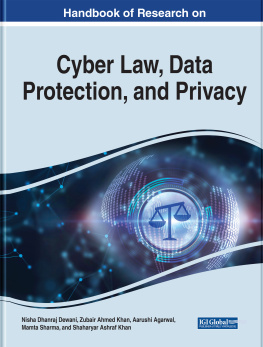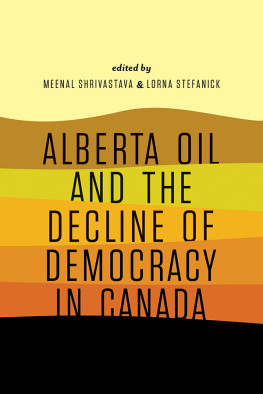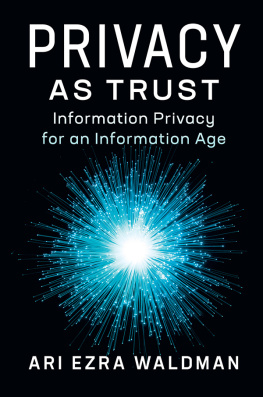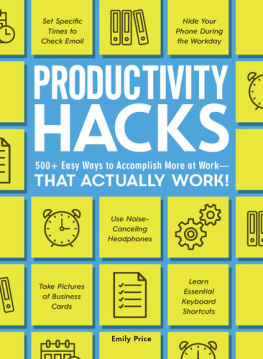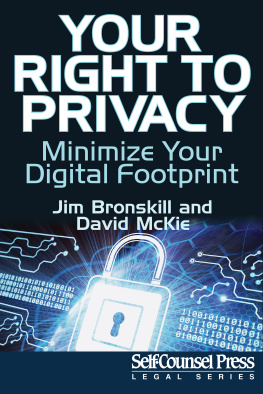CONTROLLING KNOWLEDGE 
CONTROLLING
KNOWLEDGE
Freedom of Information and Privacy Protection
in a Networked World
__ LORNA STEFANICK __

Copyright 2011 Lorna Stefanick
Published by AU Press, Athabasca University
1200, 10011 109 Street, Edmonton, AB T5J 3S6
ISBN 978-1-926836-26-3 (print)
ISBN 978-1-926836-27-0 (PDF)
ISBN 978-1-926836-61-4 (epub)
Library and Archives Canada Cataloguing in Publication
Stefanick, Lorna, 1961
Controlling knowledge : freedom of information and privacy protection in a networked world / by Lorna Stefanick.
Includes bibliographical references.
Issued also in electronic format.
ISBN 978-1-926836-26-3
1. Freedom of information.
2. Privacy, Right of.
I. Title.
K3255.S74 2011 342.0853 C2011-904732-2
Cover and interior design by Natalie Olsen, Kisscut Design.
Printed and bound in Canada by Marquis Book Printers.
We acknowledge the financial support of the Government of Canada through the Canada Book Fund (CBF) for our publishing activities.

Please contact AU Press, Athabasca University at aupress@athabascau.ca for permissions and copyright information.
To my father, George,
who taught me the importance
of integrity and accountability
and
to my mother, Millie,
who taught me the importance
of respecting personal space
CONTENTS
CH_1
An Introduction to Freedom of Information and Privacy Protection
CH_2
Privacy Protection
CH_3
Freedom of Information (FOI)
CH_4
Sharing Medical Information: Antidote or Bitter Pill?
CH_5
Surveillance in the Digital Age
CH_6
Social Networking: The Case of Facebook
CH_7
Balancing Freedom of Information and the Protection of Privacy
PREFACE AND ACKNOWLEDGEMENTS
I was first introduced to issues of information access and privacy protection when I joined the University of Albertas Faculty of Extension in 1999, where I served initially as chief editor and subsequently as associate director of the programs in the Government Studies unit. With fears of Y2K circulating like wildfire, the eve of the new millennium was a fitting time to discover what seemed to me then to be the obscure field of data management. A senior public servant in the Alberta government, Alec Campbell, asked the director of the Government Studies unit, Professor Edd LeSage, to develop a course on freedom of information and protection of privacy (FOIP) for administrators who were confronted with the FOIP legislation enacted several years earlier. And so began my involvement in the field.
Under the stewardship of Wayne MacDonald, the course rapidly expanded into Canadas only program dedicated to information rights. The popularity of this program underscores the demand for specialized education and training for lawyers, public servants, administrators, and others working in the field. The fact that the program is available online to students across the country demonstrates that it is possible to use some of the technologies discussed in this book to advance the public good. In 2003, Wayne and I negotiated the University of Albertas acquisition of a popular annual access and privacy conference. This event is attended by access and privacy commissioners from across Canada, their staff, and others working in the field; it provides an important opportunity for professional development.
It would take a family member experiencing a serious accident to really pique my interest in the subject, however. Most of us remain complacent about what information we can access and, in turn, about who has access to information about us. But when one of my daughters and her best friend were run over by a car and seriously injured, public officials told me that FOIP legislation prevented the release of information contained in an accident report and medical records. That was when my own complacency evaporated. Most of us dont recognize the importance of being able to get information until we need it. Similarly, most of us dont recognize the importance of protecting our personal information until such a time that the information is out there and we are unable to get it back. This book was written for those who are thinking that perhaps they ought to become less complacent.
Like all academic endeavours, this manuscript was long in the making and has left me deeply in debt. Athabasca University provided financial support for this project through a Research Incentive Grant and also presented me with a Presidents Award for Academic Excellence, which gave me the time I needed to complete the manuscript. I am grateful for the unflagging support of those at AU Press: Pamela MacFarland Holway, Meenal Shrivastava, Manijeh Mannani, Karen Wall, and Alvin Finkel. The decision to publish a manuscript on freedom of information with North Americas first open access academic press was a no brainer. A special debt is owed to Mary Marshall, who provided the groundwork for the chapter on privacy. In addition, Mary encouraged me to pursue the topic, read drafts, and commiserated with my complaints about struggling to maintain a balance between work and home life. Fannie Dimitriadis stimulated my thinking on surveillance, and Ben Good challenged me to develop my ideas. Paul Thomas, Wayne MacDonald, Kiran Choudhry, and Brenda Markle offered useful comments on various chapters. Thanks also to the AU breakfast group that provides such interesting conversation every Friday and whose members came up with a working title for this volume within twenty minutes of being requested to do so.
Finally, thanks to my family. Lynsey and Elena: I appreciate your patience with a mother who always demands to know why a clerk needs to have her personal information. I am also grateful that, as a pair of undergraduate students, you agreed to test drive a chapter of this book. And to Jim, as always, my toughest critic of how well arguments hang together, both in the public and the personal sphere: there is a special place in FOIP heaven for a person who reads multiple drafts of a manuscript on access and privacy.
CH_1
An Introduction to Freedom of Information and Privacy Protection
ACCESSING AND PROTECTING ELECTRONIC DATA
For anyone under the age of twenty-five living in an industrialized country, typing term papers on a typewriter or looking up books by flipping through paper index cards in a filing cabinet in the library is a completely foreign concept. Similarly, life without a laptop computer, the Internet, a cellphone, or an iPod is incomprehensible. But despite the depth of their penetration into our daily lives, the ubiquity of these communication devices is a very recent phenomenon. The proliferation of the Internet and other technological innovations in the 1990s has had a seismic impact on our ability to create, store, and share information. The subsequent development of social networking, along with the digitization of commerce and government in the following decade, has had an equally profound impact on the ways in which people communicate and go about their daily business. These changes are particularly stunning given the and e-commerce, whereby interactions between the citizen/consumer and the state/producer began to be mediated by electronic technologies. This was also the era when digital relationships came into being, that is, peer-to-peer relationships mediated by technology.
Next page

